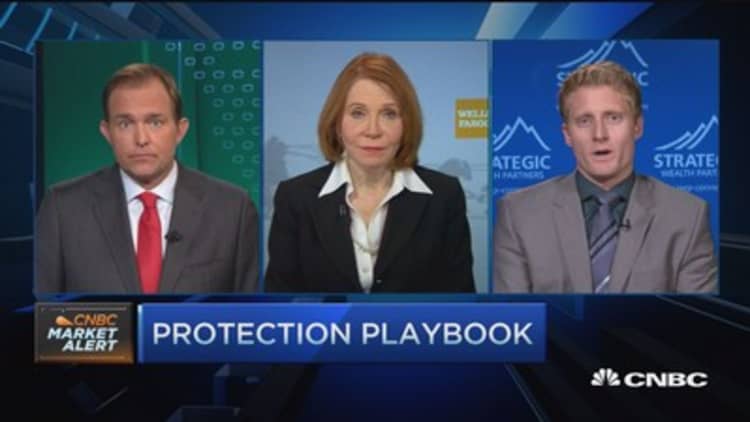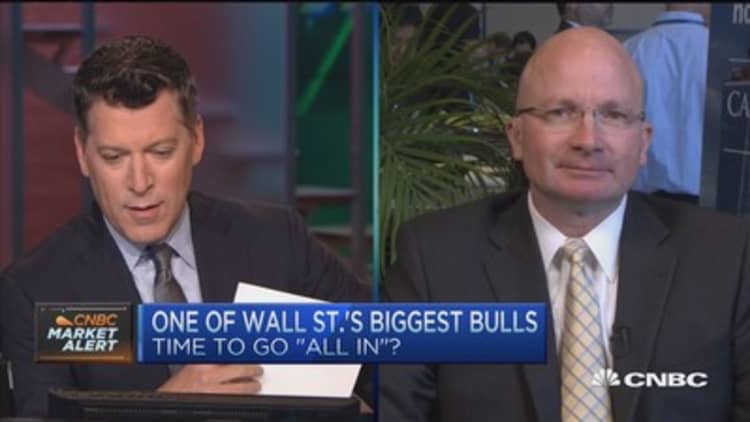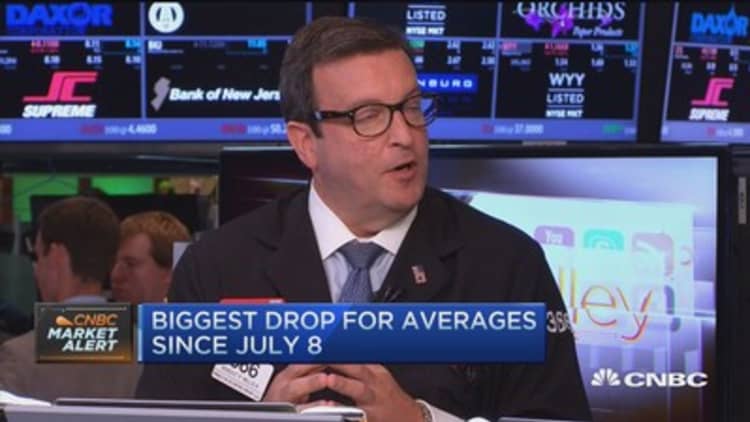


This year's flattish stock market hides a sea of turbulence under the surface—and that could be the early warning signs of a long-overdue stock market correction, some strategists say.
The S&P 500 is up about 1 percent for the year, but as of early Wednesday 56 percent of the S&P stocks were down 10 percent or more from their most recent highs. Some names in the energy sector, like Marathon Oil, Noble Energy, Transocean and Apache were down more than 50 percent.
"I think this is it. At least, it's a seasonal bull market correction. Kind of all signs point to that," said Ari Wald, technical analyst at Oppenheimer Asset Management. "You have the internal breadth breakdown. More stocks are really starting to diverge with the broad market. Momentum is waning and seasonals are very weak."
Stocks have been volatile with two days of selling this week, following China's currency devaluation, and a sharp about-face Wednesday afternoon. But the bounce higher Monday has left the S&P 500 up about 0.5 percent for the week so far. The S&P did break through a key support level of 2,063 Wednesday, but reversed and was trading above it in the afternoon as the market came well off its lows. It also rose back above its 200-day moving average, a positive sign.
Wald said the market could still have up days, and the turnaround Wednesday did not eliminate the divergences that are red flags for stocks. He said the choppy trading also comes at a normally negative time for stocks—mid-July to October.
"This is when you would expect it. We think we're set up for a 7 to 8 percent peak to a trough decline, and that would bring the S&P down to 1,970 support and that would send the S&P to a historic bull market correction. ... If you look underneath the surface, we've had some of the more glaring deterioration we've had in recent years," he said.
Read MoreMarket rout like 2008 likely ahead: strategist
As for sectors, 90 percent of the stocks in the S&P energy sector have corrected by 10 percent or more, as have 81 percent of the names in the industrial category. Nineteen out of 28 materials stocks are down more than 10 percent, and 62 percent of the names in the consumer discretionary sector have corrected. Slightly more than a third of the stocks in the S&P financial sector have corrected.
Peter Boockvar, market strategist at Lindsey Group, said he believes the market is in a correction that began a few weeks ago, starting with commodities names getting hit. The small-cap Russell 2000 was also a leader of the declines. "The key is it's infecting other areas of the market. You have every headwind and every reason to continue this correction," he said.
"Going into today, 62 percent of the NYSE stocks were trading below the 200-day moving average," said Boockvar. "More and more companies are dropping out of the bull market."
Boockvar said Wednesday's dramatic snap back in the market did not dissuade him from his view. "We've had a rolling correction. We're going to have buyers on the dip, as we did today, but I'm not changing my opinion that going into September, there's a very high chance of a correction," he said. The Dow was down more than 275 points Wednesday morning and ended the day just 40 points lower.
Paul Hickey, co-founder of Bespoke, points to market data that say there may be a reprieve for the next couple of weeks from the selling pressure. He said August historically starts off rocky but in the past 10 years, the middle of the month has been better—from Aug. 10 to Aug. 24, with a median gain of 1 percent and positive returns 60 percent of the time.
"Breadth has been weak. Whether or not this is a correction. ... There's less positives about the market than there was several months ago. So valuations aren't necessarily attractive," said Hickey, "We're getting closer and closer to when the Fed is going to raise rates. When that happens, we're anticipating volatility could pick up and you could see some short-term downside pressure. "
He said the market has been stuck. "We're right in the middle of the range we've been in. We haven't been up more than 3.5 percent this year. We haven't been down more than 3.5 percent this year. We're in the middle of the range we've been in."
The prospect of a September rate rise has also made the market anxious as traders watch each piece of economic data for what it means to the Fed's decision-making process. After Friday's strong jobs report, traders upped bets in the futures market for a September hike but they trimmed them after China devalued the yuan Monday.
Read MoreTraders bet for more pain for stocks
Traders now are talking about a slower-moving Fed. Even if it does raise short-term interest rates once in September, it may be slower to pull the trigger again if China continues to be weak or markets are in disarray.
Read MoreMarket changes mind again about rate hike
Other concerns about the stock market's behavior include the lack of leadership. Traders have been pointing to the narrowing group of winners, and the sloppy trading in some favorite names, particularly Apple. The tech giant, however, rose nearly 1.5 percent Wednesday afternoon after a 5 percent decline Tuesday, and it helped pull stocks off their lows.
Wald said he is also watching the , the CBOE volatility index, or fear meter. He expects to see it shoot higher before the market can see capitulation."We could see the VIX make it's way to the low to mid $20s. I would add that to my bottoming list," he said. The VIX was at about $14 Wednesday, up more than 1 percent after shooting above $16 earlier in the day.
Wald's also watching sentiment indicators for a bigger capitulation by bulls. "I would also be looking for some of the sentiment survey data to start showing a lot more bearishness. We've seen a little jump," he said.
Oppenheimer's bullish composite index shows investors 49 percent bullish, and Wald said a bottoming sign would be if it were to fall to 35 to 40 percent.
Boockvar said it can't be ruled out that the stock market is heading for a bigger correction that would scare off the bulls, but he's not blaming China.
"I think a lot of it will revolve around the Fed. I think they raise in mid-September and there could be a lot of skittish trading around that," he said. "This correction has more to go. To what extent, we don't know. When you're in the seventh year of a bull market, there aren't that many older than this. You have to be on the lookout for a bear market regardless of what you think about the fundamentals when you're this far into a bull market. "
Wald said he's still bullish even though he expects a shakeout. He sees the decline in commodities as a positive for stocks. "For the S&P, we've been in a range, 2,040 is the support level to watch. I do think we break below that," he said. On Tuesday, a so-called bearish death cross formed on the chart of the Dow where the 50-day moving average fell below the 200-day.
"It really is the indication of momentum declining. We've known this for awhile," Wald said. "All major tops have that formation but that formation doesn't always lead to a major top ... it gets back to how you view the longer-term evidence. Do you think this is the end of the cycle?" said Wald. He, for one does not, and points to the fact that there will still be an accomodative Fed.
"We think we find support at 1,970 (on the S&P) and that becomes an attractive buying opportunity," he said.


